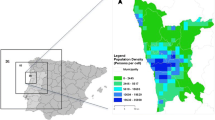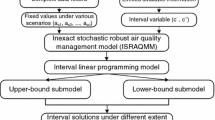Abstract
This study proposes a two-phase optimization model for regional air pollution control. To predict the pollutant concentrations at receptor zones, an interval Gaussian plume model is advanced to facilitate the generation of optimal pollution control policies. Results from the case study indicate satisfactory performance of the proposed model in handling uncertainties in parameters expressed as intervals and in stipulations associated with pollutant emission and ambient air quality. Compared with conventional models, it has advantages of generating compromised management strategies according to decision makers’ preference. This would be useful when the guarantee of satisfying all constraints is inapplicable or too costly. The proposed model is capable of identifying key factors and/or input conditions that may intensely affect system outputs and thus facilitating decision makers in adjusting current system status to benefit future management. The results also reveal a significantly enhanced satisfactory level would be obtained compared with conventional “single-phase”-based optimization models.









Similar content being viewed by others
References
Ba-Shammakh, M., Elkamel, A., Douglas, P., & Croiset, E. (2007). A mixed-integer non-linear programming model for CO2 emission reduction in the power generation sector. International Journal of Environment and Pollution, 29, 254–273.
Bourque, C. P. A. & Arp, P. A. (1996). Simulating sulfur dioxide plume dispersion and subsequent deposition downwind from a stationary point source: A model. Environmental Pollution, 91(3), 363–380.
Cao, T., Wang, M., An, L., et al. (2009). Air quality for metals and sulfur in Shanghai, China, determined with moss bags. Environmental Pollution, 157(4), 1270–1278.
Carvalho, J. C., De Vilhena, M. T. M. B., & Moreira, D. M. (2005). An alternative numerical approach to solve the Langevin equation applied to air pollution dispersion. Water, Air, & Soil Pollution, 163(1–4), 103–118.
Chang, N. B., Ning, S. K., & Chen, J. C. (2006). Multicriteria relocation analysis of an off-site radioactive monitoring network for a nuclear power plant. Environmental Management, 38(2), 197–217.
Cheng, S. Y., Li, J. B., Feng, B., et al. (2007). A Gaussian-box modeling approach for urban air quality management in a northern chinese city—I. model development. Journal Water, Air, & Soil Pollution, 178(1–4), 37–57.
Ellis, J. H. (1991). Stochastic programs for identifying critical structural collapse mechanisms. Applied Mathematical Modeling, 15, 367–379.
Ellis, H. & Bowman, M. L. (1994). Critical loads and development of acid rain control options. Journal of Environmental Engineering, 120, 273–290.
Flagan, R. C. & Seinfeld, J. H. (1988). Fundamentals of air pollution engineering. Englewood Cliffs, NJ: Prentice-Hall.
Guldmann, J. M. (1986). Interactions between weather stochasticity and the locations of pollution sources and receptors in air quality planning: A chance-constrained approach. Geography Analysis, 18, 198–214.
Guu, S. M. & Wu, Y. K. (1999). Two-phase approach for solving the fuzzy linear programming problems. Fuzzy Set & System, 107, 191–195.
Haith, A. D. (1982). Environmental systems optimization. New York: Wiley.
Hatfield, K. (1992). Coupling air quality and land use modeling within an optimization framework. Chemosphere, 25(12), 1753–1762.
He, L., Huang, G. H., Lu, H. W. (2008a). A simulation-based fuzzy chance-constrained programming model for optimal groundwater remediation under uncertainty. Advances in Water Resources, 31(12), 1622–1635.
He, L., Huang, G. H., Zeng, G. M., et al. (2008b). A fuzzy inexact mixed-integer semi-infinite programming method for municipal solid waste management planning. Journal of Environmental Engineering—ASCE, 134(7), 572–581.
He, L., Huang, G. H., & Lu, H. W. (2009a). Flexible interval mixed-integer bi-infinite programming for environmental systems management under uncertainty. Journal of Environmental Management, 90(5), 1802–1813.
He, L., Huang, G. H., Zeng, G. M., et al. (2009b). An interval-parameter mixed-integer semi-infinite programming method for municipal solid waste management. Journal of the Air & Waste Management Association, 59(2), 236–246.
Huang, G. H. (1994). Grey mathematical programming and its application to municipal solid waste management planning. PhD thesis, McMaster University, Canada.
Huang, G. H., Baetz, B. W., & Patry, G. G. (1994). Grey fuzzy dynamic programming: Application to municipal solid waste management planning problems. Civil Engineering System, 11, 43–73.
Islam, M. A. (1999). Application of a Gaussian plume model to determine the location of an unknown emission source. Water, Air, & Soil Pollution, 112(3–4), 241–245.
Koa, A. S. & Chang, N. B. (2008). Optimal planning of co-firing alternative fuels with coal in a power plant by grey nonlinear mixed integer programming model. Journal of Environmental Management, 88(1), 11–27.
Leung, Y. (1988). Spatial analysis and planning under imprecision (studies in regional science and urban economics). Amsterdam, Netherlands: Elsevier Science Publishers.
Li, Y. P., Huang, G. H., Veawab, A., et al. (2006). Two-stage fuzzy stochastic robust programming: A hybrid model for regional air quality management. Journal of the Air & Waste Management Association, 56, 1070–1082.
Lin, K. S. & Chang, N. B. (2008). Control strategy of PCDD/Fs in an industrial fluidized bed incinerator via activated carbon injection. Petroleum Science and Technology, 26(7–8), 764–789.
Lipfert, F. W., Moskowitz, P. D., & Fthenakis, V. (1995). An assessment of adult risks of paresthesia due to mercury from coal combustion. Water, Air, & Soil Pollution, 80(1–4), 1139–1148.
Liu, L., Huang, G. H., Liu, Y., & Fuller, G. A. (2003). A fuzzy-stochastic robust programming model for regional air quality management under uncertainty. Engineering Optimization, 35, 177–199.
Lu, H. W., Huang, G. H., Zeng, G. M., et al. (2008a). An interval-parameter fuzzy-stochastic programming approach for air quality management under uncertainty. Environmental Engineering Science, 25(6), 895–909.
Lu, H. W., Huang, G. H., Liu, Z. F., et al. (2008b). GHG-mitigation-induced rough-interval programming for municipal solid waste management. Journal of the Air & Waste Management Association, 58, 1546–1559.
Lu, H. W., Huang, G. H., Zeng, G. M., et al. (2009a). An inexact dynamic optimization approach for solid waste management in association with greenhouse gas emission control. Journal of Environmental Management, 90(1), 396–409.
Lu, H. W., Huang, G. H., Lin, Y. P., et al. (2009b). A two-step infinite α-cuts fuzzy linear programming method in determination of optimal allocation strategies in agricultural irrigation systems. Water Resources Management, 23(11), 2249–2269.
Page, T., Whyatt, J. D., Metcalfe, S. E., et al. (2008). Assessment of uncertainties in a long range atmospheric transport model: Methodology, application and implications in a UK context. Environmental Pollution, 156(3), 997–1006.
Robertson, E. & Barry, P. J. (1989). The validity of a Gaussian plume model when applied to elevated release at a site on the Canadian Shield. Atmospheric Environment, 23(2), 351–362.
Sivacoumar, R., Bhanarkar, A. D., & Goyal, S. K. (2001). Air pollution modeling for an industrial complex and model performance evaluation. Environmental Pollution, 111(3), 471–477.
Shaban, H. I., Elkamel, A., & Gharbi, R. (1997). An optimization model for air pollution control decision making. Environmental Modelling & Software, 12(1), 51–58.
Shih, J. S., Russell, A. G., & McRae, G. J. (1998). An optimization model for photochemical air pollution control. European Journal of Operation Research, 106, 1–14.
Werczberger, E. (1974). A mixed-integer programming model for the integration of air quality policy into land use planning. Science Association, 33, 141–154.
Werners, B. (1987). Interactive multiple objective programming subject to flexible constraints. European Journal of Operation Research, 31, 342–349.
Zimmerman, H. J. (1984). Fuzzy sets and decision analysis. Amsterdam, Holland: Elsevier Science.
Acknowledgements
This research was supported by the Major State Basic Research Development Program (2005CB724200, 2007CB714105) and the Natural Science and Engineering Research Council of Canada. The authors are extremely grateful to the editor and the anonymous reviewers for their insightful comments and suggestions.
Author information
Authors and Affiliations
Corresponding author
Rights and permissions
About this article
Cite this article
Lu, H., Huang, G. & He, L. A Two-Phase Optimization Model Based on Inexact Air Dispersion Simulation for Regional Air Quality Control. Water Air Soil Pollut 211, 121–134 (2010). https://doi.org/10.1007/s11270-009-0286-3
Received:
Accepted:
Published:
Issue Date:
DOI: https://doi.org/10.1007/s11270-009-0286-3




